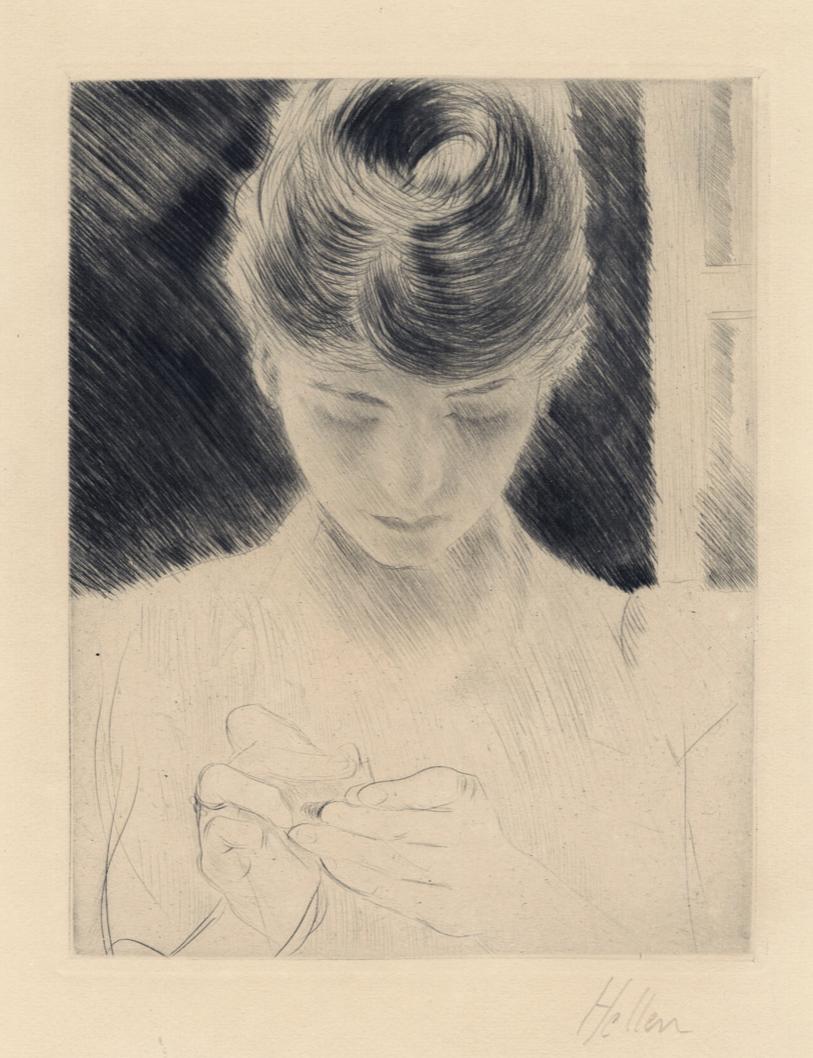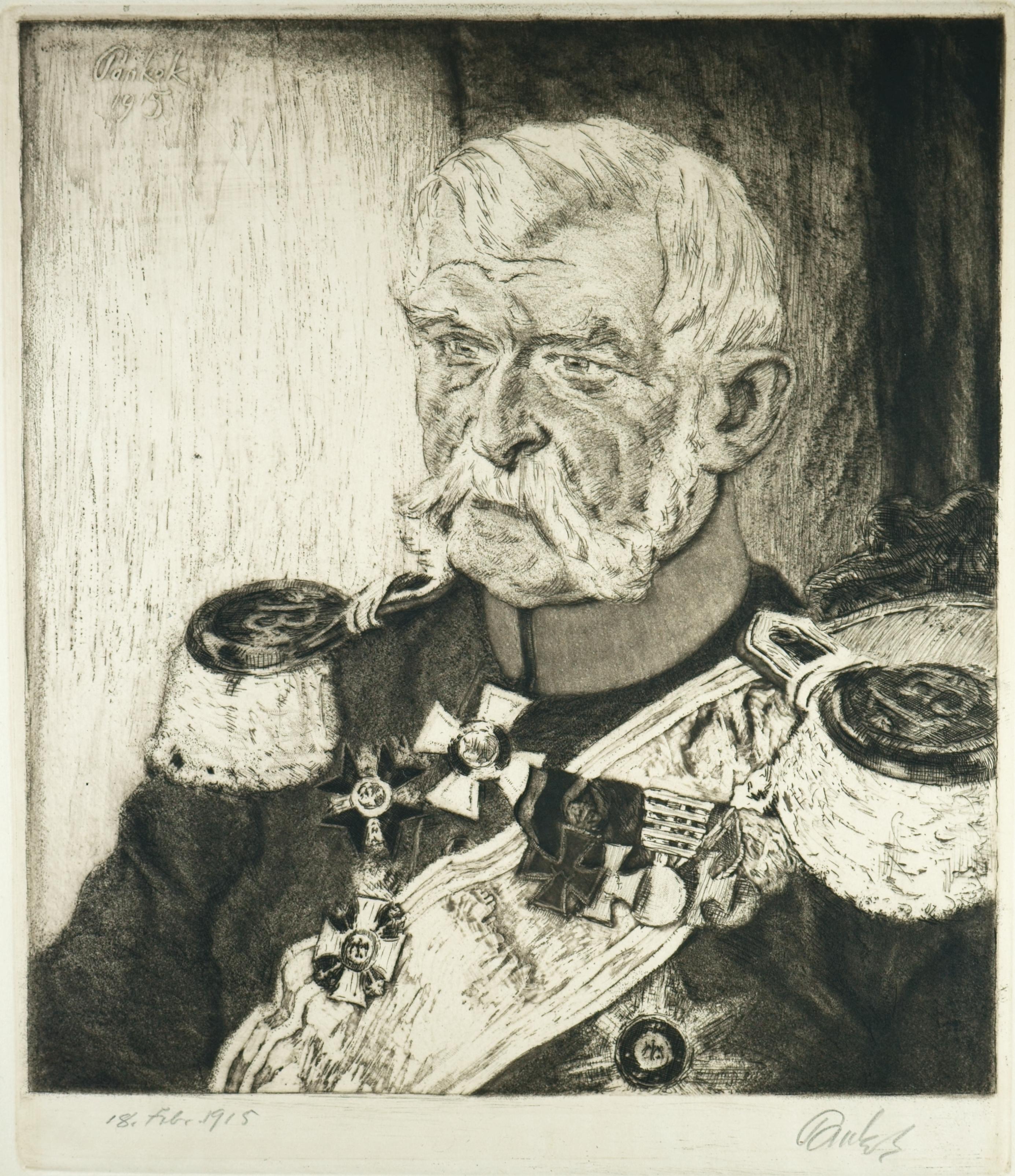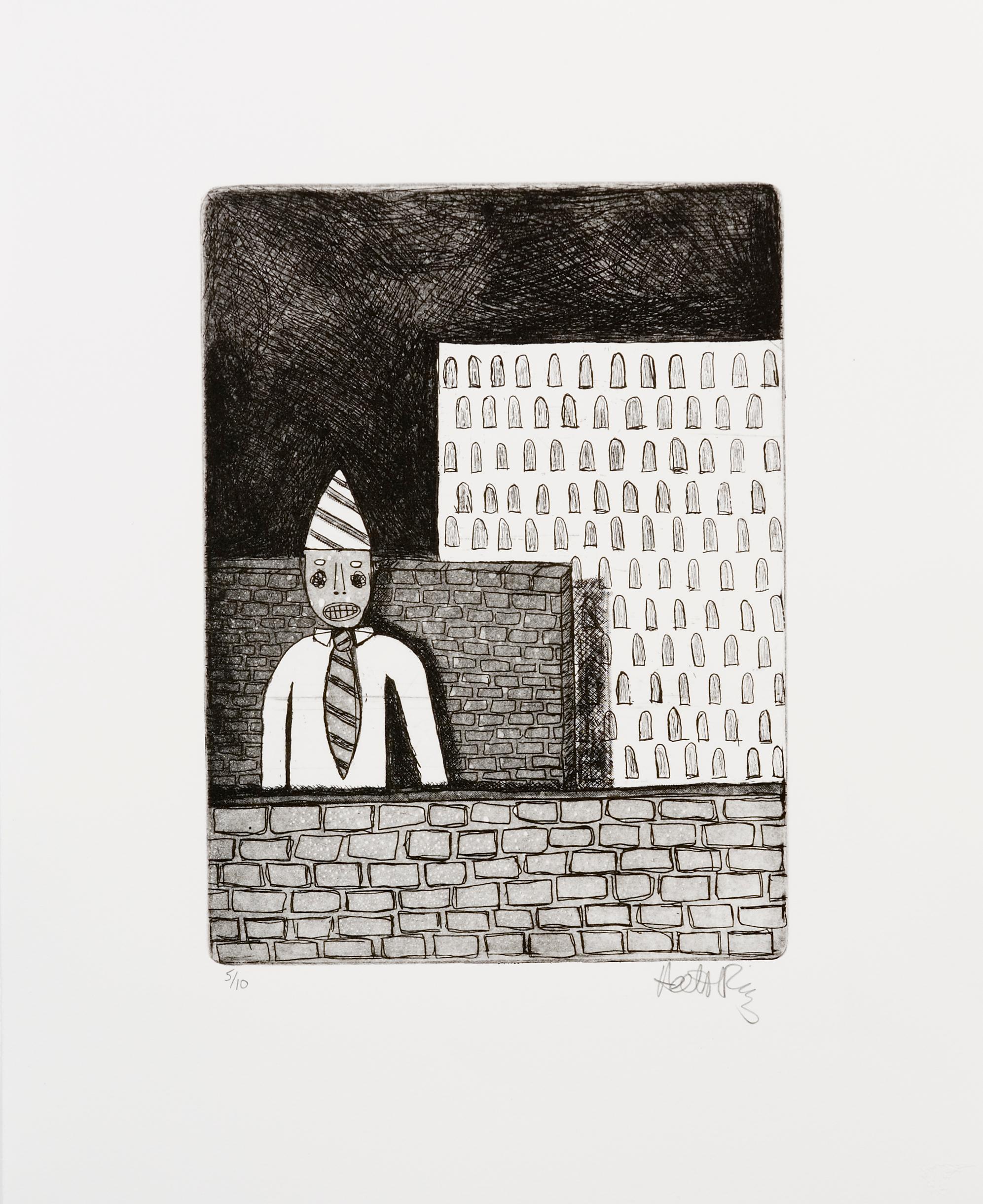Items Similar to "Sheila, " Etching and Aquatint in Color signed by Man Ray
Want more images or videos?
Request additional images or videos from the seller
1 of 8
Man Ray"Sheila, " Etching and Aquatint in Color signed by Man Ray1970
1970
About the Item
This original etching and aquatint in colors is by Surrealist and Dada artist Man Ray, an excerpt from the book "Ballade de Dames Hors du Temps".
The etching is from a sketch Man Ray drew in 1936 of the performance artist, Sheila Legge and was included in an April 1970 exhibit at the Centre Georges Pompidou entitled The Ballad of The Ladies Out of Time. The exhibit included a series of fourteen etchings accompanied by text from André Breton from 1934.
Signed in pencil lower right. Numbered 21/75 lower left.
19 1/2" x 14 1/4" art
32 1/2" x 27-1/8"frame
- Creator:Man Ray (1890 - 1976, American)
- Creation Year:1970
- Dimensions:Height: 32.5 in (82.55 cm)Width: 27.13 in (68.92 cm)
- Medium:
- Movement & Style:
- Period:
- Framing:Frame IncludedFraming Options Available
- Condition:
- Gallery Location:Milwaukee, WI
- Reference Number:
About the Seller
4.9
Platinum Seller
These expertly vetted sellers are 1stDibs' most experienced sellers and are rated highest by our customers.
Established in 1966
1stDibs seller since 2017
390 sales on 1stDibs
Typical response time: 1 hour
- ShippingRetrieving quote...Ships From: Milwaukee, WI
- Return PolicyA return for this item may be initiated within 14 days of delivery.
More From This SellerView All
- "Mes Petites Amies, Les Deux Sœurs" signed by Jacques VillonBy Jacques VillonLocated in Milwaukee, WIThis is an original drypoint and aquatint artwork by Jacques Villon. The artist signed in pencil on the lower right. As well as signed in plate at the top right of the image. This is a wonderful artwork of different intaglio processes being brought together in a beautiful almost seamless harmony. The thin pencil like markings and hair detailing are made using the Drypoint printmaking method. Whilst the color details around the girls are made using the Aquatint etching method. Jacques Villon shows his skills as a printmaker with the way these pieces line up perfectly and with how clean the rest of the plate is around the girls. Catalogue Raisonne E101, pg. 66-67 (Ginestet & Pouillon. It depicts two young girls. 15" x 11 1/2" art 25 1/8" x 20" frame French painter, printmaker and illustrator. The oldest of three brothers who became major 20th-century artists, including Raymond Duchamp-Villon and Marcel Duchamp, he learnt engraving at the age of 16 from his maternal grandfather, Emile-Frédéric Nicolle (1830-94), a ship-broker who was also a much appreciated amateur artist. In January 1894, having completed his studies at the Lycée Corneille in Rouen, he was sent to study at the Faculty of Law of the University of Paris, but within a year he was devoting most of his time to art, already contributing lithographs to Parisian illustrated newspapers such as Assiette au beurre. At this time he chose his pseudonym: Jack (subsequently Jacques) in homage to Alphonse Daudet’s novel Jack (1876) and Villon in appreciation of the 15th-century French poet François Villon...Category
Early 1900s Modern Figurative Prints
MaterialsDrypoint, Aquatint, Etching, Intaglio
- 'Self Portrait 1974' original etching signed by Sandra SweeneyBy Sandra SweeneyLocated in Milwaukee, WIFollowing in line with artists before her, like Rembrandt and van Gogh, Sandra Sweeny here presents a self portrait. The image is both direct and subtle not only in its handling of m...Category
1970s Contemporary Portrait Prints
MaterialsPaper, Etching
- "Young Girl With Hat, " Victorian Portrait Etching signed Frederick M. SpiegleBy Frederick M. SpiegleLocated in Milwaukee, WI"Young Girl With Hat" is a classical Victorian portrait etching. It is signed in graphite in the lower right by the artist, F.M. Spiegle. It depicts a Victorian girl with curly hair ...Category
Late 19th Century American Realist Portrait Prints
MaterialsInk, Paper, Etching
- "Five Dutchmen with Hats, " Original Lithograph signed by Claude WeisbuchBy Claude WeisbuchLocated in Milwaukee, WI"Five Dutchmen with Hats" is an original lithograph by Claude Weisbuch. The artist signed the piece lower right and wrote the edition number (EA 15/30) in the lower left. This piece ...Category
1970s Modern Figurative Prints
MaterialsLithograph, Paper
- "La Compagne Ed: ETAT, " Original Color Lithograph signed by Claude WeisbuchBy Claude WeisbuchLocated in Milwaukee, WI"La Lecon Du Professor Tulp" is an original lithograph by Claude Weisbuch. The artist signed the piece lower right and wrote the edition (ETAT) in the lower left. This piece depicts ...Category
1970s Modern Figurative Prints
MaterialsLithograph, Paper
- 'Hare, from Twelve Zodiac Signs' woodblock print by Utagawa KuniyoshiBy Utagawa KuniyoshiLocated in Milwaukee, WIThis print is from a highly regarded series by the Edo woodblock artist Utagawa Kuniyoshi: in the period, there were at times prohibitions in depicting a...Category
1850s Edo Figurative Prints
MaterialsPaper, Pigment, Woodcut
You May Also Like
- Balaclava - The target in sight -Located in Berlin, DEHeinrich Haberl (1869 Passau to 1934 Munich), Sturmhaube, c. 1900. drypoint, 14 x 10 cm (platemark), 28 x 21 cm (sheet size), 39 x 29 cm (passe-partout), titled "Sturmhaube" in lead at lower left and inscribed "Kaltnadelradierung", signed and locally inscribed "Heinrich Haberl Mchn. [Munich]" at lower right, inscribed again in lead on verso and with old collection stamp. - slightly darkened, fixed and mounted - The target in sight - About the artwork The theatrical "role-portrait" is to be seen against the background of the Rembrandt cult, which reached its climax at the end of the 19th century. The soldier seems to have stepped straight out of Rembrandt's Night Watch (1642) to fix something outside the picture with an alert and ready gaze. The steeply rising brim of the morion frames the gaze and thus perspectivises it as the actual 'pictorial action'. The gaze represents both the vigilant defence and the visionary goal of the battle. Not only the subject, but also the style of the etching needle reflect Rembrandt's understanding of the times. Strong contrasts of light and dark are created in a virtuoso free stroke, without losing the effect of the reflections on the helmet and in the eyes. This shows a kinship with the early prints of Lovis Corinth, who also saw himself as an artist in the role of the knight. Against this background, Haberl's picture can also be seen as a representation of his artistic self-image. About the artist Heinrich Haberl first attended the art school in Nuremberg and from 1892 studied at the Munich Academy. There he was a master student of Johann Leonhard von Raab, Rudolf von Seitz, Franz von Defregger...Category
Early 19th Century Realist Figurative Prints
MaterialsEtching
- Jeune Femme Cousant; Madame Helleu (Young Woman Sewing, artist's wife)By Paul César HelleuLocated in Middletown, NYParis: Gazette des Beaux Arts, 1892. Etching and dry point on cream laid paper. 7 9/16 x 5 7/8 inches (191 x 148 mm), full margins. Signed in pencil, lower right margin. A dark, ink...Category
Late 19th Century Realist Portrait Prints
MaterialsDrypoint, Etching
- Jim Dine Rimbaud, the Coffee Exporter poet portrait drawing in earth tone sepiaBy Jim DineLocated in New York, NYJim Dine has expertly sketched the accomplished French poet and coffee trader Arthur Rimbaud. A vignette of dark brown surrounds his thin, fine features, which are defined with a flu...Category
1970s Realist Portrait Prints
MaterialsEtching
- General Wilhelm von Blume - Visionary retrospective -Located in Berlin, DEBernhard Pankok (1872 Münster - 1943 Baierbrunn), General Wilhelm von Blume, 1915, aquatint etching, 34 x 29.5 cm (sheet size), 26 x 22 cm (plate size), signed in the plate at upper left, in pencil at lower right and dated in pencil at lower left. - At lower left old collection stamp, at the right broad margin with a small spot, otherwise very good condition. About the artwork The 1915 aquatint etching of General Wilhelm von Blume is based on a 1912 oil painting in the LWL-Museum für Kunst und Kultur in Münster. A second oil portrait of the general by Pankok is in the Staatsgalerie Stuttgart. When Pankok painted the first oil portrait in 1912, the general had already been retired for 16 years. It is therefore a retrospective portrait. Accordingly, the orientation of his head is such that he is looking back in both the oil painting and the etching. Without fixing on anything in particular, he looks thoughtfully inwards and reflects on his life. Uniformed and highly endowed, it is his military activities in particular that he is reviewing attentively and, as his gaze reveals, quite critically. Pankok has literally written the sum of his experiences on Wilhelm von Blume's face: The physiognomy is a veritable landscape of folds, furrows, ridges and gullies, all the more striking against the flat background. It is clear that each of the medals was also won through suffering. However, by breaking the boundaries of the picture, his bust appears as an unshakable massif, which gives the general a stoic quality. The fact that the design of the portrait was important to Pankok can be seen from the different versions, the present sheet being the third and probably final revision, which Pankok dates precisely to 18 February 1915. Compared with the previous state, the light background now has a dark area against which the sitter's face stands out, the dark background in turn combining with the uniform to create a new tension in the picture. Pankok's taking up of the portrait of the high-ranking military veteran and its graphic reproduction can also be seen in relation to the First World War, which had broken out in the meantime. In the face of modern weapons of mass destruction, Wilhelm von Blume's warfare and military writings were relics of a bygone, more value-oriented era. About the artist After studying at the Düsseldorf Art Academy from 1889 to 1891 under Heinrich Lauenstein, Adolf Schill, Hugo Crola, and Peter Janssen the Elder, Bernhard Pankok went to Munich in 1892, where he worked primarily as a graphic artist for the two major Jugendstil magazines "Pan" and "Jugend," which established his artistic success. Through this work he met Emil Orlik, with whom he had a lifelong friendship. In 1897, he exhibited his first furniture, and in 1898, together with Richard Riemerschmid, Bruno Paul and Hermann Obrist...Category
1910s Realist Portrait Prints
MaterialsEtching
- Cleopatra. Notes from the Underground. 1978, paper, aquatint, 22x25cmLocated in Riga, LVEpr. d'Art. Cleopatra. Notes from the Underground. 1978, paper, aquatint, 22x25 cm Lev Kropivnitsky / Лев Евгеньевич Кропивницкий (1922-1994) Russian nonconformist artists, poet,...Category
1970s Conceptual Figurative Prints
MaterialsPaper, Aquatint
- Becoming the ClownBy Hector RuizLocated in Phoenix, AZCopper etching with aquatint The power of memory and how it recalls individuality begins in such basic experiences as the ability to link internal ideas to external manifestations of those ideas. Memories as simple as an old toy or a street can set off a chain reaction of thoughts that snowball into issues as broad as nationalism, identity politics or a body politic to name a few. Hector Ruiz’s works encompass the broad, complex and often painful world particular to the Arizona and neighboring Mexican landscape. United States and Mexican border...Category
Early 2000s Street Art Figurative Prints
MaterialsCopper




